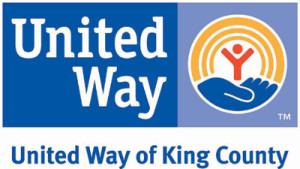 It’s right up there on the website of United Way of King County. “On average, more than 98 cents of every dollar donated goes to meet community needs.” It’s a claim The Seattle Times swallowed in a recent editorial. “The United Way of King County puts 98 cents of every dollar raised into programs and services,” the paper opined two weeks ago.
It’s right up there on the website of United Way of King County. “On average, more than 98 cents of every dollar donated goes to meet community needs.” It’s a claim The Seattle Times swallowed in a recent editorial. “The United Way of King County puts 98 cents of every dollar raised into programs and services,” the paper opined two weeks ago.
Folks, I’m here to tell you that what still may be the nation’s largest United Way unit by donations is financially efficient, but not that efficient. UWKC’s true charitable commitment is, depending on which standard methodology is used, somewhere between 91% and 96%. Put another way, that means the inefficiency in UWKC’s operations is two to four times higher than what UWKC says it is.
As I have written before, UWKC gets its 98% figure by employing a unique accounting methodology that I call Leave Out Almost All Of The Bad Stuff For Public Relations Consumption. I never saw it before becoming New To Seattle, nor have accountants I have consulted elsewhere. And I’ve been writing about charities for a long time.
For years, UWKC management insisted that the calculation be put within its formal financial statements as “supplementary information.” The methodology is so questionable that UWKC’s own auditors, perhaps fearful of losing their CPA licenses, went way out of their way in those very same statements to declare, “We do not express an opinion or provide any assurance” about that calculation. Interestingly, for the first time in awhile, UWKC’s just-released statement for the fiscal year ending June 30, 2015, doesn’t include the calculation or the disclaimer, although UWKC, as I noted, continues to tout that 98% figure.
I remain baffled by the insistence of UWKC, otherwise a reputable charity, that its charitable commitment efficiency is so high. Anything above 65% is considered satisfactory by charity watchdogs. The average charitable commitment ratio for the nation’s 50 largest charities, including United Way, is 89%. (I know this because I compile an annual list for Forbes.) So a UWKC claim of 91%–my calculation–would still look pretty good in the competitive world of charitable fundraising. But apparently not good enough for UWKC pooh-bahs.
By the way, the national average for all of United Way’s 1,000-plus chapters across the country is 86%. They operate in pretty much the same fashion, largely raising money from paycheck deductions. Yet UWKC claims its inefficiency is only one-seventh as much.
Really?
Here’s the way I see it.
In its latest financial statements (at points I am using round numbers), UWKC said it received $112 million in donations. Of that sum, $102 million came from the public, with the other $10 million from grants and corporations, including donated labor. Another $5.7 million arrived from a separate endowment for UWKC initially funded years ago by the Bill and Melinda Gates Foundation and held at the Seattle Foundation. With another $1 million in investment and other income, UWKC showed revenues of $119 million.
In my view, the donations received were not $112 million, but $112 million plus the Gates-staked endowment’s $5.7 million, for a total of $118 million. UWKC doesn’t count the Gates money as a donation, for an important reason I will explain.
On the expense side, UWKC listed $113 million directly spent on charitable purposes plus $11 million in management, certain overhead and fundraising, for total expenses of $124 million. (To make things easier, I’ll call all of the $11 million overhead.) So UWKC for the year lost $5 million. That number is clearly listed on page 4 of the statements, which you can download here.
In most of the nonprofit world, charitable commitment is calculated as direct charitable purpose expense (costs without the overhead) as a percent of total expense (costs including the overhead). The math here is simple: $113 million/$124 million, which comes to 91%–my number.
It’s rare, and not even the way the parent United Way organization prefers, but it’s also possible to compute charitable commitment as direct charitable purpose expense as a percent of donations. Here the math would be $113 million/$117 million, or 96%, although the calculation is even more iffy because UWKC ran a deficit.
UWKC has its own formula. Based on the methodology shown in previous years, here it is.
From that $11 million in overhead, UWKC subtracts $1.6 million in depreciation, even though equipment does wear out. Then it cuts $2 million in expenses covered by earmarked corporate contributions, bringing the stated overhead down to $7.4 million.
The next move is breathtaking. UWKC takes the $5.7 million from the Gates endowment and simply subtracts it from the remaining overhead, reducing the stated overhead to $1.7 million. This is called netting and is a technique used by some bad charity actors. Here, it’s very deceptive, especially since $11 million actually was spent on overhead. In my view the $5.7 million should be treated as a donation, especially since the UWKC statement says the Seattle Foundation, which holds the $156 million endowment producing the $5.7 million, has “variance power,” meaning it theoretically doesn’t have to give any of the money to UWKC.
Anyway, UWKC divides the remaining $1.7 million into the $102 million from the public to come up with a “net operating ratio” of 1.7%. Rounding that generates the aforementioned 2%. Subtracted from 100%, that produces the extraordinary efficiency of 98% rather than the respectable 91% I reckoned.
As always, I welcome below comments on these issues from interested parties and readers. It all goes to meet community needs.
Follow William P. Barrett’s work on Twitter by clicking here.
Share on Facebook
